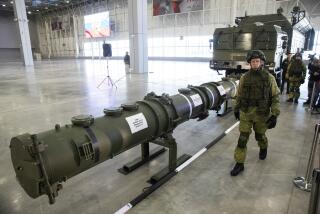Arms-Control Obstacles That Needn’t Be
- Share via
Will we soon have a nuclear arms-control agreement with the Soviet Union? Early agreement would seem highly likely in light of President Reagan’s optimistic appraisal of Soviet leader Mikhail S. Gorbachev’s proposal to eliminate all intermediate-range missiles in Europe. In fact, proponents of arms reductions suggest that such an agreement is possible in three or four months.
But some key players are not equally optimistic. Before he fell ill, Max M. Kampelman, the senior U.S. negotiator in Geneva, said that he “hopes” to reach a useful agreement “next spring (1988).” Other authoritative voices in, or close to, the Administration are raising doubts, citing three principal concerns about the wisdom of removing U.S. missiles, the difficulty of negotiating an equitable agreement with the Soviets, and the ability to verify compliance with the agreement to prevent Soviet cheating in the future.
The first concern is based on the assertion that the Soviet Union has overwhelming conventional military power that can be countered only by U.S. nuclear strength. This assertion is made so often that it is commonly accepted without question even though there is considerable evidence that it is a myth. For example, the conservative International Institute for Strategic Studies of London says in a recent analysis that the conventional balance of NATO and Warsaw Pact military forces in Europe “is still such as to make general military aggression a highly risky undertaking for either side . . . there would still appear to be insufficient overall strength on either side to guarantee victory.”
There is another reason to question any argument that 316 intermediate-range U.S. nuclear missiles are critical to nuclear deterrence or the defense of Europe. Even after all 316 are gone, the United States will still have aircraft and submarine-based missiles assigned to NATO that are capable of delivering approximately 1,200 nuclear warheads and bombs on the Soviet Union from European bases and waters.
The second reservation about obtaining an equitable arms-reduction agreement reflects a mistaken belief that devious Soviet negotiators always hornswoggle their innocent American counterparts. Former Secretary of State Henry A. Kissinger recently explained the problem this way: “Wherever the Soviets are numerically inferior they demand equal numbers; in whatever categories they are ahead they ask for equal reductions that improve their proportionate advantage.”
The record shows that the American negotiators have more than held their own. SALT II numbers are a good example. In that treaty the Soviets agreed to surrender their overall numerical advantage in strategic nuclear delivery vehicles (2,504 Soviet to 2,284 U.S.) by coming down to equal limits of 2,250 missile launchers and bombers when the treaty was ratified. The United States was not required to surrender its 2 to 1 advantage in deliverable strategic bombs and warheads (9,808 U.S. to 5,764 Soviet). Not a bad bargain!
In the present Soviet proposal the numbers favor the United States even more. Both sides would remove all intermediate-range missiles from the European theater. The Soviets would retain 100 warheads on 33 missiles in Eastern Russia while we would retain 100 warheads on 100 missiles in the United States. To reduce to equal numbers of warheads, the Soviets would have to dismantle 520 missiles and inactivate 1,336 warheads while the United States would dismantle 216 missiles, each with one warhead. Numbers never tell the whole story of an arms-control agreement, but it is fair to say that the Soviets are offering up a lot more than we are.
Finally, the issue of verification is raised by many who oppose any arms agreement with the Soviets. Perhaps the most straightforward evidence that we can verify missile levels with great confidence is provided by the Department of Defense in its publication, “Soviet Military Power.” The 1986 edition lists exactly 112 SS-4 and 441 SS-20 missiles deployed in the Soviet Union. Previous editions have carefully reported the inactivation since 1978 of 485 SS-4 and 90 SS-5 missiles as the SS-20s increased from zero to 441. All of this information was available without any special verification arrangements. If we have been able to track their intermediate-range missiles one-by-one since 1978, we certainly have the ability to keep track of them today. Furthermore, the Soviets are proposing new measures of on-site inspection in each country that would increase confidence even more that no significant cheating was possible.
Reagan has promised new “hands-on” leadership in the White House, and it appears that his personal political interests would be well served by a breakthrough on arms control after six years of no progress. For his own reasons Gorbachev has chosen to offer an agreement that is almost exactly the same “zero-option” that Reagan originally proposed for intermediate-range missiles in November, 1981. In effect, Reagan is being asked to accept “yes” for an answer to his own proposal. If the President is really back in command, that should not be hard to do.
More to Read
Get the L.A. Times Politics newsletter
Deeply reported insights into legislation, politics and policy from Sacramento, Washington and beyond. In your inbox three times per week.
You may occasionally receive promotional content from the Los Angeles Times.










